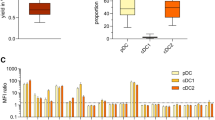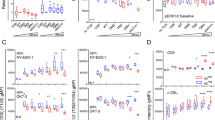Abstract
The in vitro generation of cytotoxic T lymphocytes (CTLs) for anticancer immunotherapy is a promising approach to take patient-specific therapy from the bench to the bedside. Two criteria must be met by protocols for the expansion of CTLs: high yield of functional cells and suitability for good manufacturing practice (GMP). The antigen presenting cells (APCs) used to expand the CTLs are the key to achieving both targets but they pose a challenge: Unspecific stimulation is not feasible because only memory T cells are expanded and not rare naïve CTL precursors; in addition, antigen-specific stimulation by cell-based APCs is cumbersome and problematic in a clinical setting. However, synthetic artificial APCs which can be loaded reproducibly with MHC-peptide monomers and antibodies specific for costimulatory molecules could resolve these problems. The purpose of this study was to investigate the potential of complex synthetic artificial APCs in triggering the costimulatory molecules CD28 and 4-1BB on the T cell. Anti-4-1BB antibodies were added to an established system of microbeads coated with MHC-peptide monomers and anti-CD28. Triggering via CD28 and 4-1BB resulted in strong costimulatory synergy. The quantitative ratio between these signals determined the outcome of the stimulation with optimal results when anti-4-1BB and anti-CD28 were applied in a 3:1 ratio. Functional CTLs of an effector memory subtype (CD45RA− CCR7−) were generated in high numbers. We present a highly defined APC platform using off-the-shelf reagents for the convenient generation of large numbers of antigen-specific CTLs.




Similar content being viewed by others
References
Altman JD, Moss PA, Goulder PJ, Barouch DH, McHeyzer-Williams MG, Bell JI, McMichael AJ, Davis MM (1996) Phenotypic analysis of antigen-specific T lymphocytes. Science 274:94–96
Arch RH, Thompson CB (1998) 4-1BB and Ox40 are members of a tumor necrosis factor (TNF)-nerve growth factor receptor subfamily that bind TNF receptor-associated factors and activate nuclear factor κB. Mol Cell Biol 18:558–565
Bender A, Sapp M, Schuler G, Steinman RM, Bhardwaj N (1996) Improved methods for the generation of dendritic cells from nonproliferating progenitors in human blood. J Immunol Methods 196:121–135
Boise LH, Minn AJ, Noel PJ, June CH, Accavitti MA, Lindsten T, Thompson CB (1995) CD28 costimulation can promote T cell survival by enhancing the expression of Bcl-xL. Immunity 3:87–98
Chu ZL, McKinsey TA, Liu L, Gentry JJ, Malim MH, Ballard DW (1997) Suppression of tumor necrosis factor-induced cell death by inhibitor of apoptosis c-IAP2 is under NF-кB control. Proc Natl Acad Sci USA 94:10057–10062
DeBenedette MA, Shahinian A, Mak TW, Watts TH (1997) Costimulation of CD28- T lymphocytes by 4-1BB ligand. J Immunol 158:551–559
Garni-Wagner BA, Lee ZH, Kim YJ, Wilde C, Kang CY, Kwon BS (1996) 4-1BB is expressed on CD45RAhiROhi transitional T cell in humans. Cell Immunol 169:91–98
Geginat J, Lanzavecchia A, Sallusto F (2003) Proliferation and differentiation potential of human CD8+ memory T-cell subsets in response to antigen or homeostatic cytokines. Blood 101:4260–4266
Goodwin RG, Din WS, vis-Smith T, Anderson DM, Gimpel SD, Sato TA, Maliszewski CR, Brannan CI, Copeland NG, Jenkins NA (1993) Molecular cloning of a ligand for the inducible T cell gene 4-1BB: a member of an emerging family of cytokines with homology to tumor necrosis factor. Eur J Immunol 23:2631–2641
Grad JM, Zeng XR, Boise LH (2000) Regulation of Bcl-xL: a little bit of this and a little bit of STAT. Curr Opin Oncol 12:543–549
Guelly C, Kupcu Z, Zalusky D, Karner M, Zehetner M, Schweighoffer T (2002) Activation requirements of circulating antigen-specific human CD8(+) memory T cells probed with insect cell-based artificial antigen-presenting cells. Eur J Immunol 32:182–192
Hurtado JC, Kim SH, Pollok KE, Lee ZH, Kwon BS (1995) Potential role of 4-1BB in T cell activation. Comparison with the costimulatory molecule CD28. J Immunol 155:3360–3367
Khoshnan A, Tindell C, Laux I, Bae D, Bennett B, Nel AE (2000) The NF-κB cascade is important in Bcl-xL expression and for the anti-apoptotic effects of the CD28 receptor in primary human CD4+ lymphocytes. J Immunol 165:1743–1754
Kwon BS, Weissman SM (1989) cDNA sequences of two inducible T-cell genes. Proc Natl Acad Sci USA 86:1963–1967
Laderach D, Movassagh M, Johnson A, Mittler RS, Galy A (2002) 4-1BB costimulation enhances human CD8+ T cell priming by augmenting the proliferation and survival of effector CD8+T cells. Int Immunol 14:1155–1167
Latouche JB, Sadelain M (2000) Induction of human cytotoxic T lymphocytes by artificial antigen-presenting cells. Nat Biotechnol 18:405–409
Lee HW, Park SJ, Choi BK, Kim HH, Nam KO, Kwon BS (2002) 4-1BB promotes the survival of CD8+ T lymphocytes by increasing expression of Bcl-xL and Bfl-1. J Immunol 169:4882–4888
Lutz MB, Schuler G (2002) Immature, semi-mature and fully mature dendritic cells: which signals induce tolerance or immunity? Trends Immunol 23:445–449
Maus MV, Thomas AK, Leonard DG, Allman D, Addya K, Schlienger K, Riley JL, June CH (2002) Ex vivo expansion of polyclonal and antigen-specific cytotoxic T lymphocytes by artificial APCs expressing ligands for the T-cell receptor, CD28 and 4-1BB. Nat Biotechnol 20:143–148
Melero I, Shuford WW, Newby SA, Aruffo A, Ledbetter JA, Hellstrom KE, Mittler RS, Chen L (1997) Monoclonal antibodies against the 4-1BB T-cell activation molecule eradicate established tumors. Nat Med 3:682–685
Melero I, Bach N, Hellstrom KE, Aruffo A, Mittler RS, Chen L (1998) Amplification of tumor immunity by gene transfer of the costimulatory 4-1BB ligand: synergy with the CD28 co-stimulatory pathway. Eur J Immunol 28:1116–1121
Montes M, Rufer N, Appay V, Reynard S, Pittet MJ, Speiser DE, Guillaume P, Cerottini JC, Romero P, Leyvraz S (2005) Optimum in vitro expansion of human antigen-specific CD8 T cells for adoptive transfer therapy. Clin Exp Immunol 142(2):292–302
Nastke MD, Herrgen L, Walter S, Wernet D, Rammensee HG, Stevanovic S (2005) Major contribution of codominant CD8 and CD4 T cell epitopes to the human cytomegalovirus-specific T cell repertoire. Cell Mol Life Sci 62:77–86
Oelke M, Maus MV, Didiano D, June CH, Mackensen A, Schneck JP (2003) Ex vivo induction and expansion of antigen-specific cytotoxic T cells by HLA-Ig-coated artificial antigen-presenting cells. Nat Med 9:619–624
Oelke M, Kurokawa T, Hentrich I, Behringer D, Cerundolo V, Lindemann A, Mackensen A (2000) Functional characterization of CD8(+) antigen-specific cytotoxic T lymphocytes after enrichment based on cytokine secretion: comparison with the MHC-tetramer technology. Scand J Immunol 52:544–549
Picker LJ, Singh MK, Zdraveski Z, Treer JR, Waldrop SL, Bergstresser PR, Maino VC (1994) Direct demonstration of cytokine synthesis heterogeneity among human memory/effector T cells by flow cytometry. Blood 86(4):1408–1419
Riddell SR, Greenberg PD (1990) The use of anti-CD3 and anti-CD28 monoclonal antibodies to clone and expand human antigen-specific T cells. J Immunol Methods 128:189–201
Sallusto F, Lenig D, Förster R, Lipp M, Lanzavecchia A (1999) Two subsets of memory T lymphocytes with distinct homing potentials and effector functions. Nature 401:708–712
Sallusto F, Geginat J, Lanzavecchia A (2004) Central memory and effector memory T cell subsets: function, generation, and maintenance. Annu Rev Immunol 22:745–763
Savage P, Gao L, Vento K, Cowburn P, Man S, Steven N, Ogg G, McMichael A, Epenetos A, Goulmy E, Stauss HJ (2004) Use of B cell-bound HLA-A2 class I monomers to generate high-avidity, allo-restricted CTLs against the leukemia-associated protein Wilms tumor antigen. Blood 103:4613–4615
Schilbach K, Kerst G, Walter S, Eyrich M, Wernet D, Handgretinger R, Xie W, Rammensee HG, Müller I, Bühring HJ, Niethammer D (2005) Cytotoxic minor histocompatibility antigen HA-1-specific CD8+ effector memory T cells: Artificial APCs pave the way for clinical application by potent primary in vitro induction. Blood 106:144–149
Schirle M, Keilholz W, Weber B, Gouttefangeas C, Dumrese T, Becker HD, Stevanovic S, Rammensee HG (2000) Identification of tumor-associated MHC class I ligands by a novel T cell-independent approach. Eur J Immunol 30:2216–2225
Shuford WW, Klussman K, Tritchler DD, Loo DT, Chalupny J, Siadak AW, Brown TJ, Emswiler J, Raecho H, Larsen CP, Pearson TC, Ledbetter JA, Aruffo A, Mittler RS (1997) 4-1BB costimulatory signals preferentially induce CD8+ T cell proliferation and lead to the amplification in vivo of cytotoxic T cell responses. J Exp Med 186:47–55
Stevanovic S (2002) Identification of tumour-associated T-cell epitopes for vaccine development. Nat Rev Cancer 2:514–520
Takahashi C, Mittler RS, Vella AT (1999) Cutting edge: 4-1BB is a bona fide CD8 T cell survival signal. J Immunol 162:5037–5040
Tan JT, Whitmire JK, Murali-Krishna K, Ahmed R, Altman JD, Mittler RS, Sette A, Pearson TC, Larsen CP (2000) 4-1BB costimulation is required for protective anti-viral immunity after peptide vaccination. J Immunol 164:2320–2325
Thomas AK, Maus MV, Shalaby WS, June CH, Riley JL (2002) A cell-based artificial antigen-presenting cell coated with anti-CD3 and CD28 antibodies enables rapid expansion and long-term growth of CD4 T lymphocytes. Clin Immunol 105:259–272
Trickett A, Kwan YL (2003) T cell stimulation and expansion using anti-CD3/CD28 beads. J Immunol Methods 275:251–255
Turka LA, Ledbetter JA, Lee K, June CH, Thompson CB (1990) CD28 is an inducible T cell surface antigen that transduces a proliferative signal in CD3+ mature thymocytes. J Immunol 144:1646–1653
Valmori D, Fonteneau JF, Lizana CM, Gervois N, Lienard D, Rimoldi D, Jongeneel V, Jotereau F, Cerottini JC, Romero P (1998) Enhanced generation of specific tumor-reactive CTL in vitro by selected Melan-A/MART-1 immunodominant peptide analogues. J Immunol 160:1750–1758
Vasto S, Clonna-Romano G, Larbi A, Wikby A, Calogero C, Pawelec G (2007) Role of persistent CMV infection in configuring T cell immunity in the elderly. Immun Ageing 4:2–7
Walter S, Herrgen L, Schoor O, Jung G, Wernet D, Buhring HJ, Rammensee HG, Stevanovic S (2003) Cutting edge: predetermined avidity of human CD8 T cells expanded on calibrated MHC/anti-CD28-coated microspheres. J Immunol 171:4974–4978
Yan X, Johnson BD, Orentas RJ (2004) Murine CD8 lymphocyte expansion in vitro by artificial antigen-presenting cells expressing CD137L (4-1BBL) is superior to CD28, and CD137L expressed on neuroblastoma expands CD8 tumour-reactive effector cells in vivo. Immunology 112:105–116
Zippelius A, Pittet MJ, Batard P, Rufer N, de Smedt M, Guillaume P, Ellefsen K, Valmori D, Lienard D, Plum J, MacDonald HR, Speiser DE, Cerottini JC, Romero P (2002) Thymic selection generates a large T cell pool recognizing a self-peptide in humans. J Exp Med 195:485–494
Acknowledgments
We thank Pierre van der Bruggen (Ludwig Institute for Cancer Research, Brussels) for the LG2-EBV cell line, Claus Garbe (Dermatology Department, University of Tübingen) for the melanoma cell lines and Hans Stauss (Imperial College, London) for the BV-173 cell line. This work was supported by Deutsche Forschungsgemeinschaft (DFG, SFB 685), NIH Grant RO1 EY013325 and SRC funds from KOSEF and MOST, Korea.
Author information
Authors and Affiliations
Corresponding author
Additional information
Despina Rudolf and Tobias Silberzahn have contributed equally to this work.
Rights and permissions
About this article
Cite this article
Rudolf, D., Silberzahn, T., Walter, S. et al. Potent costimulation of human CD8 T cells by anti-4-1BB and anti-CD28 on synthetic artificial antigen presenting cells. Cancer Immunol Immunother 57, 175–183 (2008). https://doi.org/10.1007/s00262-007-0360-x
Received:
Accepted:
Published:
Issue Date:
DOI: https://doi.org/10.1007/s00262-007-0360-x




